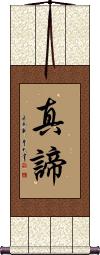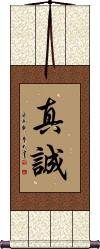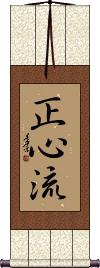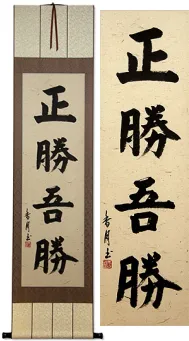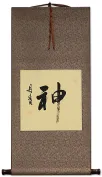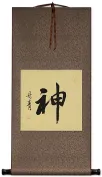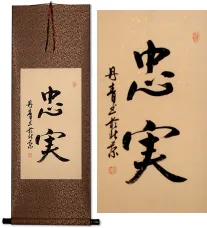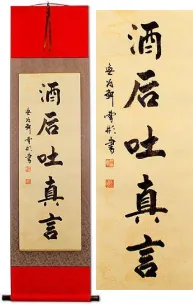Many custom options...
And formats...

Not what you want?
Try other similar-meaning words, fewer words, or just one word.
True Essence in Chinese / Japanese...
Buy a True Essence calligraphy wall scroll here!
Personalize your custom “True Essence” project by clicking the button next to your favorite “True Essence” title below...
True Essence
Sincere / True Sincerity
真誠 is the true essence of sincerity.
It takes strength of personality to be truly sincere without overdoing it. Speaking of strength, this is probably the strongest way to convey the idea of sincerity in the Chinese language.
The first character literally means true, real, and genuine. While the second character means sincere and honest.
Shoshin-Ryu
正心流 is a Japanese title that means “right heart style” or “true mind method.”
The first character means right, correct, greater, or true.
The second character means heart, mind, soul, or essence.
The third character means style, method, or some will translate it as a school.
Please note, there is more than one martial arts school that romanizes as Shoshin-Ryu.
Lingering Mind
Zanshin
First off, 殘心 should only be used in the context of Japanese martial arts. In Chinese, it's a rather sad title (like a broken heart). In Chinese, the first character alone means destroyed, spoiled, ruined, injured, cruel, oppressive, savage, incomplete, or disabled. However, in Japanese, it's remainder, leftover, balance, or lingering.
The second character means heart, mind, soul, or essence in both languages.
殘心 is one of the five spirits of the warrior (budo) and is often used as a Japanese martial arts tenet. Under that context, places such as the Budo Dojo define it this way: The spirit of zanshin is the state of the remaining or lingering spirit. It is often described as a sustained and heightened state of awareness and mental follow-through. However, true zanshin is a state of focus or concentration before, during, and after the execution of a technique, where a link or connection between uke and nage is preserved. Zanshin is the state of mind that allows us to stay spiritually connected, not only to a single attacker but to multiple attackers and even an entire context; a space, a time, an event.
![]() In modern Japan (and Simplified Chinese), they use a different version of the first character, as seen to the right. Click on this character to the right instead of the button above if you want this modern Japanese version of lingering mind / zanshin.
In modern Japan (and Simplified Chinese), they use a different version of the first character, as seen to the right. Click on this character to the right instead of the button above if you want this modern Japanese version of lingering mind / zanshin.
This in-stock artwork might be what you are looking for, and ships right away...
Gallery Price: $200.00
Your Price: $122.88
Gallery Price: $90.00
Your Price: $49.88
Gallery Price: $168.00
Your Price: $92.88
Not the results for true essence that you were looking for?
Below are some entries from our dictionary that may match your true essence search...
| Characters If shown, 2nd row is Simp. Chinese |
Pronunciation Romanization |
Simple Dictionary Definition |
真諦 真谛 see styles |
zhēn dì zhen1 di4 chen ti shintai; shintei / shintai; shinte しんたい; しんてい |
More info & calligraphy: True Essence(1) {Buddh} (esp. しんたい) (See 俗諦) ultimate truth; (2) (esp. しんてい) essence; (person) Paramartha (499-569 CE) |
一如 see styles |
yī rú yi1 ru2 i ju ichinyo いちにょ |
to be just like oneness; (personal name) Kazuyuki The one ru, i.e. the bhūtatathatā, or absolute, as the norm and essence of life. The 眞如 true suchness, or true character, or reality; the 法性 nature of things or beings. The whole of things as they are, or seem; a cosmos; a species; things of the same order. Name of a celebrated monk, Yiru. V. 一眞; 一實. |
三身 see styles |
sān shēn san1 shen1 san shen sanjin; sanshin さんじん; さんしん |
{Buddh} trikaya (three bodies of the Buddha); (surname) Sanmi trikāya. 三寶身 The threefold body or nature of a Buddha, i.e. the 法, 報, and 化身, or dharmakāya, sambhogakāya, and nirmāṇakāya. The three are defined as 自性, 受用, and 變化, the Buddha-body per se, or in its essential nature; his body of bliss, which he "receives" for his own "use" and enjoyment; and his body of transformation, by which he can appear in any form; i.e. spiritual, or essential; glorified; revealed. While the doctrine of the trikāya is a Mahāyāna concept, it partly results from the Hīnayāna idealization of the earthly Buddha with his thirty-two signs, eighty physical marks, clairvoyance, clairaudience, holiness, purity, wisdom, pity, etc. Mahāyāna, however, proceeded to conceive of Buddha as the Universal, the All, with infinity of forms, yet above all our concepts of unity or diversity. To every Buddha Mahāyāna attributed a three-fold body: that of essential Buddha; that of joy or enjoyment of the fruits of his past saving labours; that of power to transform himself at will to any shape for omnipresent salvation of those who need him. The trinity finds different methods of expression, e.g. Vairocana is entitled 法身, the embodiment of the Law, shining everywhere, enlightening all; Locana is 報身; c.f. 三賓, the embodiment of purity and bliss; Śākyamuni is 化身 or Buddha revealed. In the esoteric sect they are 法 Vairocana, 報 Amitābha, and 化 Śākyamuni. The 三賓 are also 法 dharma, 報 saṅgha, 化 buddha. Nevertheless, the three are considered as a trinity, the three being essentially one, each in the other. (1) 法身 Dharmakāya in its earliest conception was that of the body of the dharma, or truth, as preached by Śākyamuni; later it became his mind or soul in contrast with his material body. In Mādhyamika, the dharmakāya was the only reality, i.e. the void, or the immateria1, the ground of all phenomena; in other words, the 眞如 the tathāgatagarbha, the bhūtatathatā. According to the Huayan (Kegon) School it is the 理or noumenon, while the other two are氣or phenomenal aspects. "For the Vijñānavāda... the body of the law as highest reality is the void intelligence, whose infection (saṃkleҫa) results in the process of birth and death, whilst its purification brings about Nirvāṇa, or its restoration to its primitive transparence" (Keith). The "body of the law is the true reality of everything". Nevertheless, in Mahāyāna every Buddha has his own 法身; e.g. in the dharmakāya aspect we have the designation Amitābha, who in his saṃbhogakāya aspect is styled Amitāyus. (2) 報身Sambhogakāya, a Buddha's reward body, or body of enjoyment of the merits he attained as a bodhisattva; in other words, a Buddha in glory in his heaven. This is the form of Buddha as an object of worship. It is defined in two aspects, (a) 自受用身 for his own bliss, and (b) 他受用身 for the sake of others, revealing himself in his glory to bodhisattvas, enlightening and inspiring them. By wisdom a Buddha's dharmakāya is attained, by bodhisattva-merits his saṃbhogakāya. Not only has every Buddha all the three bodies or aspects, but as all men are of the same essence, or nature, as Buddhas, they are therefore potential Buddhas and are in and of the trikāya. Moreover, trikāya is not divided, for a Buddha in his 化身 is still one with his 法身 and 報身, all three bodies being co-existent. (3) 化身; 應身; 應化身 nirmāṇakāya, a Buddha's transformation, or miraculous body, in which he appears at will and in any form outside his heaven, e.g. as Śākyamuni among men. |
圓覺 圆觉 see styles |
yuán jué yuan2 jue2 yüan chüeh engaku |
Complete enlightenment potentially present in each being, for all have 本覺 primal awareness, or 眞心 the true heart (e. g. conscience), which has always remained pure and shining; considered as essence it is the 一心 one mind, considered causally it is the Tathāgata-garbha, considered it is|| perfect enlightenment, cf. 圓覺經. |
地体 see styles |
jitai じたい |
(1) (archaism) essence; true nature; substance; reality; (adverb) (2) (archaism) originally; naturally; by nature; from the start |
如實 如实 see styles |
rú shí ru2 shi2 ju shih nyo jitsu |
as things really are; realistic Real, reality, according to reality ( yathābhūtam); true; the 眞如 zhenru, or bhūtatathatā, for which it is also used; the universal undifferentiated, i. e. 平等不二, or the primary essence out of which the phenomenal arises; 如實空 is this essence in its purity; 如實不空 is this essence in its differentiation. |
實性 实性 see styles |
shí xìng shi2 xing4 shih hsing jisshō |
Real nature, or essence, i.e. the 眞如 bhūtatathatā. |
實相 实相 see styles |
shí xiàng shi2 xiang4 shih hsiang jissō |
actual situation; the ultimate essence of things (Buddhism) Reality, in contrast with 虛妄; absolute fundamental reality, the ultimate, the absolute; the 法身, i.e. dharmakāya, or 眞如 bhūtatathatā. Other terms are 一實; 一如; 一相; 無相; 法證; 法位; 涅槃; 無爲; 眞諦; 眞性; 眞空; 實性; 實諦; 實際, q.v. |
本質 本质 see styles |
běn zhì ben3 zhi4 pen chih honshitsu ほんしつ |
essence; nature; innate character; intrinsic quality (noun - becomes adjective with の) essence; true nature; substance; reality Original substance, the substance itself; any real object of the senses. |
法身 see styles |
fǎ shēn fa3 shen1 fa shen hosshin; houshin / hosshin; hoshin ほっしん; ほうしん |
{Buddh} (See 三身) dharmakaya (dharma body, Buddhism's highest form of existence); (surname) Hotsushin dharmakāya, embodiment of Truth and Law, the "spiritual" or true body; essential Buddhahood; the essence of being; the absolute, the norm of the universe; the first of the trikāya, v.三身. The dharmakāya is divided into 總 unity and 別 diversity; as in the noumenal absolute and phenomenal activities, or potential and dynamic; but there are differences of interpretation, e.g. as between the 法相 and 法性 schools. Cf. 法身體性. There are many categories of the dharmakāya. In the 2 group 二法身 are five kinds: (1) 理 "substance" and 智 wisdom or expression; (2) 法性法身 essential nature and 應化法身 manifestation; the other three couples are similar. In the 3 group 三法身 are (1) the manifested Buddha, i.e. Śākyamuni; (2) the power of his teaching, etc.; (3) the absolute or ultimate reality. There are other categories. |
眞空 see styles |
zhēn kōng zhen1 kong1 chen k`ung chen kung mahiro まひろ |
(female given name) Mahiro (1) The absolute void, complete vacuity, said to be the nirvana of the Hīnayāna. (2) The essence of the bhūtatathatā, as the 空眞如 of the 起信論, 唯識, and 華嚴. (3) The void or immaterial as reality, as essential or substantial, the 非 空 之 空 not-void void, the ultimate reality, the highest Mahāyāna concept of true voidness, or of ultimate reality. |
理法界 see styles |
lǐ fǎ jiè li3 fa3 jie4 li fa chieh ri hokkai |
One of the 四界, that of the common essence or dharmakāya of all beings. |
The following table may be helpful for those studying Chinese or Japanese...
| Title | Characters | Romaji (Romanized Japanese) | Various forms of Romanized Chinese | |
| True Essence | 真諦 真谛 | shintai / shintei | zhēn dì / zhen1 di4 / zhen di / zhendi | chen ti / chenti |
| Sincere True Sincerity | 真誠 真诚 | zhēn chéng zhen1 cheng2 zhen cheng zhencheng | chen ch`eng chencheng chen cheng |
|
| Shoshin-Ryu | 正心流 | shou shin ryuu shoushinryuu sho shin ryu | ||
| Lingering Mind | 殘心 残心 | zan shin / zanshin | cán xīn / can2 xin1 / can xin / canxin | ts`an hsin / tsanhsin / tsan hsin |
| In some entries above you will see that characters have different versions above and below a line. In these cases, the characters above the line are Traditional Chinese, while the ones below are Simplified Chinese. | ||||
Successful Chinese Character and Japanese Kanji calligraphy searches within the last few hours...
